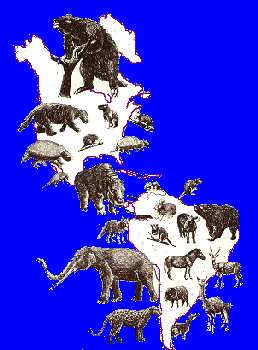
MODULE 15: Historical Biogeography
Objectives: In this module you will gain an understanding of the major processes that control the distribution of plants and animals over long geological intervals. You will explore several examples of biogeographic patterns expressed in the fossil record.
Background:
Biogeography (or "Zoogeography) is the study of the distribution of animals and plants and the reasons for those distributions. Plants and animals "are where they are" because of a complex set of environmental controls that impact their survival including physical factors (e.g., yearly temperature ranges, moisture) and biological factors (competition, tolerance of environmental extremes, ability to disperse etc.). Over long intervals of time, plant and animal distribution can be strongly influenced by changing geography (e.g., plate movements, plate separations/collisions and mountain building) and climate change (e.g., glacial episodes). Even extraterrestrial factors such as meteorite impacts can influence the long-term distributions of animal and plant groups. (Tell me more about biogeography) (Even More on biogeography!)
Mammal Biogeography Example: (Shifting Continents and Splendid Isolation)
The lands and oceans which mammals occupy are not stationary or stable features over geologic time. Continents actually move and oceans open wider (e.g., the Atlantic) at mid-ocean ridges or narrow (e.g., the Pacific) at ocean trenches at a rate of a few inches a year! While this may seem trivial, over long intervals of time these inches add up and continents can reconfigure their positions dramatically (e.g., they can move 60 miles in a million years, 600 miles in 10 million years). Along with these plate shifts, mountains form where continents collide or where one plate subducts beneath another. This plate tectonic activity is extremely critical for mammals, because as thew plates move, plants and animals become geographically separated from their sibling groups/species, they begin to evolve in "isolation" promoting even greater diversification and new species.
What have been the major geographical changes on earth effecting the course of Mammalian history???
A Brief Chronology:
250 mya Permian-Triassic interval: Figure The supercontinent PANGAEA is assembled Mammal-like Reptiles can move freely between many of the sutured continents.
185-65 mya Jurassic-Cretaceous interval: Figure Pangaea is breaking apart. Dinosaurs and mammals can move between continents, but the connections (land bridges) are disappearing. For example, North and South America are becoming isolated.
65 mya -present: Paleocene to Eocene interval: Figure Continents continue to separate. North America and Europe still have a good connection. Australia, Antarctica, and South America have a good connection. Madagascar is isolated from Africa. India is moving towards Asia. Oligocene interval: Australia is now separate from Antarctica and the connection between Europe and N. America is chronic. Miocene-Pliocene interval: The African connection to Europe and Asia is stronger and India is tightly linked to Asia. Major Glaciation begins. Pleistocene to Present: Major glaciation intensifies lowering sea level and promoting connections between South and North America, Asia and Australia, Africa and Europe, and Russia and North America.

The figure above depicts the kinds of mammals that crossed Central America during the "Great American Biotic Interchange" during the late Miocene and Pleistocene interval. Mammal groups that had been evolving in isolation on the South American continent for tens of millions of years and counterpart groups on North America dispersed to each other's continents. Horses were one of the groups that crossed the land bridge (moving south). The fossil record demonstrates that the South American mammals had been isolated for a very long time and several novel groups had evolved including the Astrapotheres, Notoungulates and the Glyptodonts that are recovered from the Villa Vieja and the La Venta deposits of Columbia. (Be sure to look at the pictures for La Venta!)
Plant Example of Biogeography: (Climate Change and Vegetation Shifts)
Just like the mammals, plant distributions have also shifted due to movements of the great plates or because of significant global climate shifts. Paleobotanists have discerned dramatic shifts in the earth's vegetation patterns corresponding to changing climate belts during the recent glacial episodes. As the climate became colder during the glacial maxima, much of North America was uninhabitable by plants and animals alike. Take a look at what happened to paleovegetation during the glacial interval.